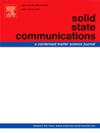K2AgSbI6的DFT研究:探索双钙钛矿的电子、光学和弹性性质
IF 2.1
4区 物理与天体物理
Q3 PHYSICS, CONDENSED MATTER
引用次数: 0
摘要
K2AgSbI6是一种无铅双钙钛矿,利用密度泛函理论(DFT)研究了它作为光电子器件的有前途的生态友好候选者。利用CASTEP程序系统分析了K2AgSbI6的电子、光学和力学性能,采用PBE-GGA泛函进行结构和力学计算,HSE06混合泛函进行带隙细化。该材料的间接带隙为0.391 eV (GGA)和0.597 eV (HSE06),符合其半导体性质,而光吸收光谱在2.86 eV(可见范围,~ 433 nm)处显示出一个强峰,吸收系数为8.75 × 105 cm−1,非常适合可见光捕获。通过Born标准确认了机械稳定性,计算出的弹性常数产生16.75 GPa的体积模量和延性行为(Pugh比>;1.75),表明柔性设备集成的鲁棒性。声子色散分析证实了动态稳定性,排除了软模式。离子取代效应和Kramers-Kronig相互作用的相互作用支撑了微妙的带隙变化,尽管注意到DFT方法的局限性。这些结果将K2AgSbI6定位为下一代光伏和光电子学的可持续高性能材料。本文章由计算机程序翻译,如有差异,请以英文原文为准。
DFT study on K2AgSbI6: Exploring the electronic, optical, and elastic properties of a double perovskite
K2AgSbI6, a lead-free double perovskite, is investigated as a promising eco-friendly candidate for optoelectronic devices using density functional theory (DFT). The electronic, optical, and mechanical properties of cubic-phase K2AgSbI6 are systematically analyzed with the CASTEP code, employing the PBE-GGA functional for structural and mechanical calculations and the HSE06 hybrid functional for bandgap refinement. The material exhibits an indirect bandgap of 0.391 eV (GGA) and 0.597 eV (HSE06), consistent with its semiconducting nature, while optical absorption spectra reveal a strong peak at 2.86 eV (visible range, ∼433 nm) with a high absorption coefficient of 8.75 × 105 cm−1, ideal for visible-light harvesting. Mechanical stability is confirmed via Born criteria, with calculated elastic constants yielding a bulk modulus of 16.75 GPa and ductile behavior (Pugh's ratio >1.75), indicating robustness for flexible device integration. Phonon dispersion analysis confirms dynamical stability, ruling out soft modes. The interplay of ionic substitution effects and Kramers-Kronig interactions underpins subtle bandgap variations, though limitations of the DFT methodology are noted. These results position K2AgSbI6 as a sustainable, high-performance material for next-generation photovoltaics and optoelectronics.
求助全文
通过发布文献求助,成功后即可免费获取论文全文。
去求助
来源期刊

Solid State Communications
物理-物理:凝聚态物理
CiteScore
3.40
自引率
4.80%
发文量
287
审稿时长
51 days
期刊介绍:
Solid State Communications is an international medium for the publication of short communications and original research articles on significant developments in condensed matter science, giving scientists immediate access to important, recently completed work. The journal publishes original experimental and theoretical research on the physical and chemical properties of solids and other condensed systems and also on their preparation. The submission of manuscripts reporting research on the basic physics of materials science and devices, as well as of state-of-the-art microstructures and nanostructures, is encouraged.
A coherent quantitative treatment emphasizing new physics is expected rather than a simple accumulation of experimental data. Consistent with these aims, the short communications should be kept concise and short, usually not longer than six printed pages. The number of figures and tables should also be kept to a minimum. Solid State Communications now also welcomes original research articles without length restrictions.
The Fast-Track section of Solid State Communications is the venue for very rapid publication of short communications on significant developments in condensed matter science. The goal is to offer the broad condensed matter community quick and immediate access to publish recently completed papers in research areas that are rapidly evolving and in which there are developments with great potential impact.
 求助内容:
求助内容: 应助结果提醒方式:
应助结果提醒方式:


